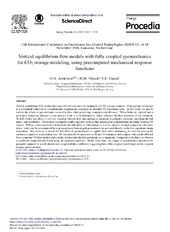| dc.contributor.author | Andersen, Odd | |
| dc.contributor.author | Nilsen, Halvor Møll | |
| dc.contributor.author | Gasda, Sarah Eileen | |
| dc.date.accessioned | 2017-11-08T09:12:05Z | |
| dc.date.available | 2017-11-08T09:12:05Z | |
| dc.date.issued | 2017 | |
| dc.Published | Andersen OA, Nilsen HM, Gasda SE. Vertical Equilibrium Flow Models with Fully Coupled Geomechanics for CO2 Storage Modeling, Using Precomputed Mechanical Response Functions. Energy Procedia. 2017;114:3113-3131 | eng |
| dc.identifier.issn | 1876-6102 | en_US |
| dc.identifier.uri | https://hdl.handle.net/1956/16903 | |
| dc.description.abstract | Vertical equilibrium (VE) models have proved to be attractive for simulation of \co storage scenarios. Their primary advantage is a substantial reduction in computational requirements compared to standard 3D simulation tools. In this work, we aim to include the effects of geomechanics on aquifer flow while preserving computational efficiency. When fluids are injected into a geological formation, changes in pore pressure leads to rock deformation, which influence the flow properties of the formation. To fully model this effect, a two way coupling between flow and mechanics equations is generally necessary, including the full under- and overburden. This leads to a computationally expensive system, thus reducing the computational advantage of using VE models. Within a linear poroelastic framework, the full effect of deformation on flow is captured through changes in volumetric strain, which can be precomputed for a given pressure basis at grid generation time and used directly in the flow equations during simulation. This allow us to model the full effect of geomechanics on aquifer flow while eliminating the need for solving the mechanics equations at simulation time. We demonstrate the approach on 2D and 3D examples, and compare with results obtained from a standard VE flow models and a model that includes the full poroelastic set of equations. Compared to the latter, we observe a significant computational benefit using our proposed approach. On the other hand, the impact of geomechanics appears to be primarily captured by a well-chosen rock compressibility coefficient, suggesting that a fully coupled model might not be required in many practical cases. | en_US |
| dc.language.iso | eng | eng |
| dc.publisher | Elsevier | en_US |
| dc.relation.ispartof | <a href="http://hdl.handle.net/1956/15477" target="blank">Simplified models for numerical simulation of geological CO2 storage</a> | en_US |
| dc.rights | Attribution CC BY-NC-ND | eng |
| dc.rights.uri | http://creativecommons.org/licenses/by-nc-nd/4.0/ | eng |
| dc.subject | Vertical equilibrium | eng |
| dc.subject | linear poroelasticity | eng |
| dc.subject | poromechanics | eng |
| dc.subject | CCS | eng |
| dc.title | Vertical Equilibrium Flow Models with Fully Coupled Geomechanics for CO2 Storage Modeling, Using Precomputed Mechanical Response Functions | en_US |
| dc.type | Peer reviewed | |
| dc.type | Journal article | |
| dc.date.updated | 2017-09-27T05:41:13Z | |
| dc.description.version | publishedVersion | en_US |
| dc.rights.holder | Copyright 2017 The Author(s) | en_US |
| dc.identifier.doi | https://doi.org/10.1016/j.egypro.2017.03.1440 | |
| dc.identifier.cristin | 1498211 | |
| dc.source.journal | Energy Procedia | |

